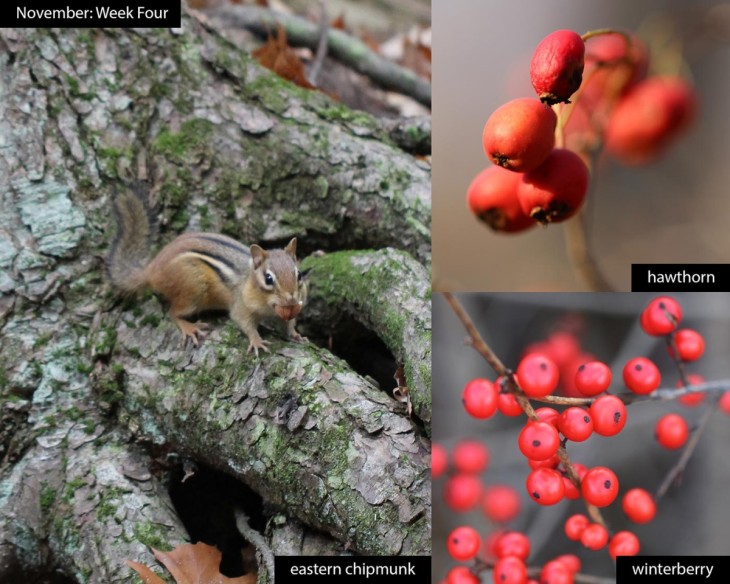This week in the woods, an eastern chipmunk paused with an acorn and retreated into its winter burrow beneath some tree roots in Fairlee, Vermont. This foraging trip was likely among the rodent’s last before it enters winter torpor. Chipmunks are not true hibernators, waking every week or so to feed off the underground granary they stock through the fall and venturing outside for food only on warmer days. A chipmunk can stuff up to a dozen acorns into its mouth pouch, but because we only see one here, it seems likely that the chippie collected it close to home. (See Elise Tillinghast’s 2020 Outside Story article “Chipmunk Game Theory 101” for more on the calculus that goes into a chipmunk’s food transportation.)
In its annual survey, the Vermont Fish & Wildlife Department reported excellent acorn availability this year throughout much of the Connecticut River Valley. In mast years such as this one, oaks in one area produce synchronized crops so large that the odds increase for any given acorn to avoid the chipmunks, squirrels, bears, deer, mice, and various bird species that eat acorns. Many species of wildlife rely on hard mast – acorns, other nuts, and seeds, which are calorie dense and store well through winter. However, eating high-sugar soft mast such as cherries and berries before they spoil can also help animals gain fat during this crucial time of year. And unlike with hard mast, where consumption means that a nut or seed won’t become a plant or tree, consumption of soft mass often aids the plants, as digested seeds can still spread and germinate.
Tree field guides give counts for native and naturalized hawthorn species in North America ranging from 20 to what David Sibley calls “overzealous” figures above 1,000. The many species vary minutely from one another – and, adding further to potential ID confusion, characteristics can differ branch to branch. A botany professor once told of a group of mischievous students who made him sort hawthorn leaf and twig clippings by species only to reveal that they had all come from the same tree. Whatever the species, in autumn and winter, we can see hawthorns’ thorny twigs and small, rounded buds covered by thick, fleshy scales. Dozens of bird species eat the small, red, apple-like fruit that hangs from long stems. The widely spaced spines that today fail to deter livestock and deer would have warded off the now-extinct ground sloths, mastodons, and mammoths of ten millennia ago.
Another shrub we saw this week that produces soft mass, winterberry, favors acidic soils and in turn bears acidic fruit. The acidity may explain why the berries often persist for much of the holly’s namesake season, only to become valuable food for hungry birds and mammals in lean times.
What have you noticed in the woods this week? Submit a recent photo for possible inclusion in our monthly online Reader Photo Gallery.



Discussion *